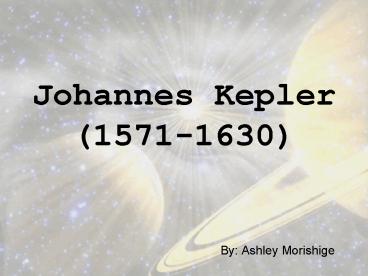Johannes Kepler 15711630 PowerPoint PPT Presentation
1 / 11
Title: Johannes Kepler 15711630
1
Johannes Kepler(1571-1630)
- By Ashley Morishige
2
Kepler in Context
- 1571-1630 Keplers Life
- 1450 1650 Age of Discovery (Vasco da Gama,
Columbus, Pizarro, Magellan) - 1517 Birth of Protestantism with Luthers 95
Theses - 1540 start of Counter and Catholic
Reformations as a reaction to Protestantism - 1559 Spain wins Spanish-French wars
- 1559-1589 civil unrest in France
- 1588 Spanish Armada defeated by British
- 1618 1648 Thirty Years War
- Late 1500s baroque art and music
3
Kepler the Scientific Revolution
- Scientific Revolution - started around 1600
- -a shift from a religious toward a scientific
world view - Some Important Figures and Their Contributions
- -Copernicus heliocentric solar system
- -Brahe observations of planets
- -Galileo telescope and kinematics
- -Kepler laws of planetary motion
- -Harvey blood circulation
- -Descartes deductive reasoning
- -Newton Calculus, 3 laws of Motion, Universal
Gravitation
4
Johannes Kepler Biography
- Lived 1571-1630
- Born in Weil der Stadt, Germany
- Raised by his grandparents
- Schooling
- Latin School
- Protestant seminary at Adelberg
- Protestant University of Tubingen
- 1597 married Barbara Muller
5
Kepler More Biography
- Michael Maestlin taught Kepler about Copernicus
heliocentric system - Kepler went on to be a professor in Austria
- studied astronomy and astrology in his free time
- Published The Cosmographic Mystery
- Tycho Brahe invited Kepler to assist him in 1600
- When Brahe died, Kepler became Imperial
Mathematician in Prague - Studied the heavens and produced many volumes
about his discoveries - Died in Regensburg in 1630
6
Johannes Kepler-Laws of Planetary Motion-
- After studying Tycho Brahes observations, Kepler
came up with his 3 Laws of Planetary Motion - Newton in Principia Mathematica (1687) showed how
to deduce the 3 laws from Newtons 2nd Law of
Motion and the Law of Universal Gravitation. - (Section 14.4 and the applied project following
it contain the proofs of the 3 laws)
7
Keplers Laws of Planetary Motion
- A planet revolves around the Sun in an elliptical
orbit with the Sun at one focus. - The line joining the Sun to a planet sweeps out
equal areas in equal times - The squares of the periods of the planets are
proportional to the cubes of the lengths of the
major axes of their orbits.
8
1) A planet revolves around the Sun in an
elliptical orbit with the Sun at one focus.
- Ellipse Equation
9
2) The line joining the Sun to a planet sweeps
out equal areas in equal times
- In order for an object along an elliptical orbit
to sweep out the area at a uniform rate, the
object moves quickly when the radius vector is
short and the object moves slowly when the radius
vector is long.
10
3) The squares of the periods of the planets are
proportional to the cubes of the lengths of the
major axes of their orbits.
- A planets orbital period squared is
proportional to its average distance from the sun
cubed. The length of the semimajor axis is the
average distance from the sun.
(orbital period)2 (average distance from sun)3
11
Resources
- Stewart, James. Calculus. 5th ed. Thomson United
states, 2003. - "Scientific revolution." Wikipedia, The Free
Encyclopedia. 25 Sep 2006, 1833 UTC. Wikimedia
Foundation, Inc. 26 Sep 2006 lthttp//en.wikipedia.
org/w/index.php?titleScientific_revolutionoldid
77759717gt. - The Galileo Project. lthttp//galileo.rice.edu/sci/
kepler.htmlgt. - Kepler Mission. http//kepler.nasa.gov/johannes/in
dex.htmlanchor784359. - http//www.bnsc.gov.uk/assets/channels/education/a
e/Solar_System.gif - http//salmenhigh.stpsb.org/clubs/solar-system-nas
a.jpg - http//home.cvc.org/science/kepler.htm
- http//astrosun2.astro.cornell.edu/academics/cours
es//astro201/orbits_kepler.htm - http//www.bun.kyoto-u.ac.jp/suchii/intro.PS/kepl
aw.jpg - Schmiechen, James. A History of Western Society
Study Guide II. 7th ed. Houghton Mifflin Boston,
2003. - http//www.edinphoto.org.uk/0_MAPS/0_map_world_200
2.jpg

